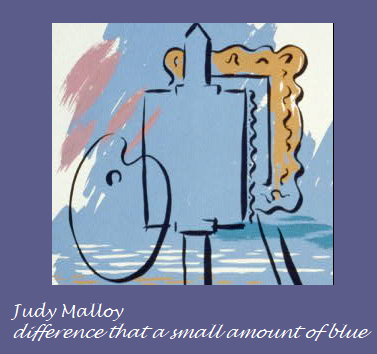difference that a small amount of blue
brings three core works together
in the way that they have always belonged.
They are:
Dorothy Abrona McCrae, an electronic manuscript about the intertwined lives of a painter, Dorothy Abrona McCrae, and San Francisco Gallery owner Sid Seibelman, begins the trilogy. The story is set in Dorothy's studio/residence in the California Gold Country foothills. In her distinctive voice -- simultaneously archaic (in the classical sense) and iconoclastic -- a narrative unfolds in fragmented lexias. At the core of the manuscript, recollective meaning is altered by a series of events that are revealed through letters, art work, and conversations.
In 2000, when it was written, several goals informed Dorothy Abrona McCrae. At the core of my work is the lives of artists. I had already written a work of electronic literature about a woman artist, the generative hypertext its name was Penelope, which is about a woman conceptual photographer. I was beginning work on my MIT Press book, Women, Art and Technology, but I was also working as the editor of Arts Wire Current (now NYFA Current), which covered all the arts. I was very aware of the historic role of women painters in breaking the boundaries that had kept women artists outside the mainstream art world, and I wanted to create an iconic woman painter. Dorothy Abrona McCrae's life has no resemblance to the life of younger Bay Area Figurative painter, Joan Brown, who died in an accident in 1990. Nevertheless, Joan Brown was always inspirational.
Additionally, I was interested in how the basic building block of the lexia, in combination with marginalia links, could create an electronic manuscript that would hold reader attention and at the same time lead (with A Party in Silverbeach and Paths of Memory and Painting) into a reader experience of the range and possibilities of electronic manuscripts. The easiest way to read Dorothy Abrona McCrae is to click on the text or the space bar below the text and advance to the next lexia.
A Party at Silver Beach, the second narrative in difference that a small amount of blue, moves the reader to an artists' beach house-situated party, where lovers come and go, missing each other, finding each other. And sporadic dark conversations punctuate the generally joyous experience of the celebration of the wedding of a painter and a curator. The narrator is Jenny, the narrator of Uncle Roger.
Throughout this work, each lexia is accessed by an icon, or to put it another way, the icons that surround the lexia space are linking devices that deliver the texts, and as if at a real party, (or in a graphic-accessed work of interactive fiction) the viewer wanders through the six scenes that comprise A Party at Silver Beach in the same way one would experience a real party, ie the clickable icons represent guests at the party, food, champagne, music, views to the ocean, and the house and gallery where the celebration takes place. Although it plays virtually on a computer screen, SilverBeach was influenced by Renaissance masques that were presented at Italian courts for occasions such as the weddings of royalty, and the work also has the feel of a pastoral Purcell masque or semi-opera interlude.
In the third narrative, as if music-playing on the River Thames was imagined in the California hills -- celebrating painters, rather than royalty and playing in three suites -- Paths of Painting and Memory sets Dorothy Abrona McCrae on a recollected journey that begins with painting in the California Hills during World War II. A reading experience is created, in which a painter's thoughts while returning to painting in the hills are densely revealed. Lexias are piled one atop of another in eight adjacent stacks in an array. New information is displayed as the reader confronts multiple paths.
The works that comprise difference that a small amount of blue are documented in more detail in "about" files within each work.
